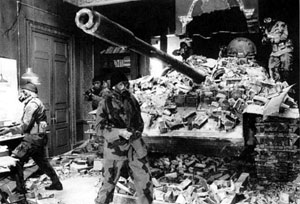| CAPTION :
TWO POWERFUL FAMILIES ARE BATTLING FOR CONTROL
OF THE COUNTRY.
THE FIELD HEADQUARTERS OF THE KING'S ARMY |
CAPTION. This was
only agreed once the film was complete. I should have preferred to
do without it, as the long, wordless prologue (scenes 1-13)
gradually introduces the faces of the principal players and hints
at their relationships. Before Richard's first speech, it is
important to understand that his story develops against the
background of a civil war. The caption explains this rather less
extensively than Shakespeare's King Henry VI trilogy about
the Wars of the Roses! In the film, the less advance warning the
better - enough for the audience to know that a rebel army is
closing in on the reigning King. |
| SCENE 1
INT. DRAWING-ROOM OF COUNTRY MANSION - NIGHT
In the countryside away from the capital, KING HENRY'S forces
have requisitioned a small-scale stately home for their temporary
military headquarters.
The drawing-room is comfortable and traditionally decorated -
chintz combined with velvet and brocades. From the rose of an
ornately plastered ceiling hangs a discreet chandelier. The
mullioned windows are shuttered against spying eyes. Coals burn
red in the marbled fireplace.
Cables snake down the walls, bringing electricity for telephones
and lighting to the military occupants. Harsh, bare lightbulbs. A
large, operations map of England is pinned onto a tapestry.
KING HENRY embraces his beloved son and heir, PRINCE EDWARD,
and retires for the night, through double-doors to his makeshift,
bedroom sanctuary. An armed CORPORAL stands easy outside.
PRINCE EDWARD, with his long-haired RETRIEVER for company,
quietly settles down to a night of paperwork. An ADJUTANT brings a
tray with the Prince's supper.
PRINCE EDWARD sits at a large desk, illuminated by an
anglepoisc lamp. As he eats, reads and makes notes, he adjusts the
position of the silver-framed photo of his beloved wife, LADY
ANNE. |
Scene I was devised by
RL to establish the 1930s setting and to present the militaristic
background to the civilian politics of the film. It has startling
sound effects, no music and only a few scarcely distinguishable
words.
The set of the country mansion was originally
built and designed for a BBC TV production by our production
designer Tony Burrough. Rather than throw them in the incinerator.
Tony had rescued the walls of timber and canvas and, at his own
cost, stored them for a rainy day in a warehouse in the north of
England, whence they were brought south to Spitfire Studios in
Middlesex and re-erected and furnished. This was a generous gift,
as the set was to be destroyed on camera. Unless it's RL, I've
never seen a harder worker than Tony.
He looked at various stately homes of England in
which to film. He says: "We decided they were too safe and we
wanted to be brave. We were creating our own world, our own
history of the 1930s and our invention of what might have happened
if Britain had been involved in a civil war sixty years ago. We
decided we wanted to find eccentric places and turn them into
elements of the story." (So the scenery was never to be just
decoration and glamour for their own sakes.)
"We decided Victorian Gothic was a nice way
of placing King Edward's court in a traditional context. When
Richard takes over, he moves his headquarters away from the palace
into accommodation derivative of Speer's Berlin or Mussolini's
Rome.
'We drew on elements we liked about the look of
the 1930s as they really were and used them as keys. The costumes,
for example, were very specific to 1936. Shuna Harwood, the
costume designer, scoured the vintage clothing stores of London
and Pans for 30s originals. We're using 30s furniture and props
and architecture that has survived from the 30s. The style of the
picture, however, is heightened reality. We haven't been slavish
to period detail. Some things which might not be accurate look
perfect in context. That's the great thing about movies: you can
cheat. We didn't compromise - Richard Loncraine is very
uncompromising!' |
| There are soft sounds of normal,
peaceful activity - scratch of PRINCE EDWARD'S pen, scrape of fork
on china, ticking of a grandfather clock. The only sense of war is
the Morse code receiver clicking outside in the Hall.
The alert dog hears it first. An unidentifiable creaking
rumble. Is it getting louder? PRINCE EDWARD looks up from his desk
and rises to open a shutter and peer outside. The whimpering dog
is more interested in the opposite outer wall. His sudden barking
is drowned by an unholy roar.
PRINCE EDWARD turns - to see the entire wall cave in, as an
army tank enters the drawing-room. Furniture is crushed and
priceless plaster falls and chokes the air. Before he can react, a
rifle shot splatters the back of his head across a painting of an
idyllic rural scene. The GUARD and ADJUTANT are also shot.
Then the electricity fails and the lights go out. An explosion and
a ball of fire backlight the tank lodged in the shattered wall.
Through the flames and the acrid smoke, RICHARD, DUKE OF
GLOUCESTER, in full battle-gear and disguised by a gas mask,
emerges from behind the tank, leading half a dozen COMMANDOS. |

As the tank's appearance could not be rehearsed
nor repeated, four cameras filmed its one-and-only entrance. I
suggested that the silence after its deafening arrival could be
broken by footsteps of panic, preferably in time to the iambic
pentameter thud of 'de-dum, de-dum, de-dum, de-dum, de-dum'. It
was explained that panic is rarely regular. So, instead, I
breathed rhythmically through the gas-mask. It is appropriate that
Richard's face should at first sight be masked - as are his
feelings from the world. |
